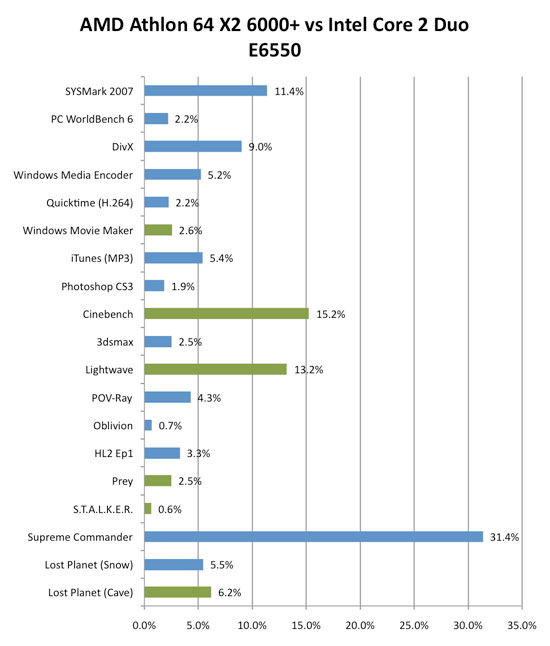Intel Core 2 Extreme QX9650 - Penryn Ticks Ahead
by Anand Lal Shimpi on October 29, 2007 12:13 AM EST- Posted in
- CPUs
Another Price Drop? A Competitive Update
Although this couldn't be further from the matter at hand, AMD has quietly dropped its prices since the last time we looked at upper mainstream performance. The new/old AMD pricing structure is as follows:
| CPU | Old Price | New Price |
| AMD Athlon 64 FX-74 | $599/pair | $599/pair |
| AMD Athlon 64 X2 6000+ | $178 | $167 |
| AMD Athlon 64 X2 5600+ | $157 | $146 |
| AMD Athlon 64 X2 5200+ | $136 | $125 |
| AMD Athlon 64 X2 5000+ | $125 | $115 |
| AMD Athlon 64 X2 4800+ | $115 | $104 |
| AMD Athlon 64 X2 4400+ | $94 | $89 |
| AMD Athlon 64 X2 4000+ | $73 | $68 |
| AMD X2 BE-2350 | $91 | $96 |
| AMD X2 BE-2300 | $73 | $91 |
The price changes are fairly minor, but they do change the way we have to compare these processors. For example, the Athlon 64 X2 6000+ used to be priced close to the Core 2 Duo E6750, but now it's an E6550 competitor, improving AMD's competitive stance. For some reason, AMD's 45W Athlon X2 processors actually went up in price, possibly due to fluctuation in yields.
The other major change is that below the 6000+, all of AMD's chips compete with Intel's E4000/E2000 series, not the E6000 line. We'll be working on an update to our Midrange CPU Roundup to take some of these changes into account, but for this review we'll do a quick update looking at the 6000+ compared to its new price competitor, the E6550.
The chart below shows the percent difference in scores between the 6000+ and the E6550; the blue bars mean that Intel won that test and the green bars indicate that AMD won:

AMD definitely gets more competitive with its price drop, but Intel still holds on to the competitive advantage. Not only is the E6550 faster overall, it is also a cooler running processor (keeping in mind that the 6000+ is still a 90nm core) with more overclocking headroom.










16 Comments
View All Comments
emenk - Sunday, January 20, 2008 - link
From first page (this article): "As we saw in our original Penryn preview, Penryn's cache performance remains unchanged; latencies in our final stepping are identical to Conroe."From the original Penryn preview (3rd page):
"Not only is Wolfdale's L2 cache larger, but it also happens to be slightly faster than its predecessor. Intel has shaved off a single clock cycle from Wolfdale's L2 access time; we're already off to a good start."
Isn't this a contradiction?
Ignore this (testing quote tags):
[quote]Quote goes here.[/quote]
IntelUser2000 - Tuesday, October 30, 2007 - link
You know that will not be true in the true Phenom comparison right Anand?? Take a look here: http://techreport.com/articles.x/8236/14">http://techreport.com/articles.x/8236/14Dual Opteron is slower than a Single Opteron, yet you still used Dual Opteron against a single Barcelona. Why?? No really, WHY?!?
"Because of these limitations we refrained from running any comparative benchmarks to desktop Athlon 64 X2s, instead we chose to run a single quad-core Opteron in our server platform against a pair of dual-core Opterons to simulate Phenom vs. K8 on the desktop."
You could have took games like Oblivion with Single socket Opteron to see the real advantages. This is the worst comparison, ever. And to make it worse, you put "simulated" benchmarks.
victory - Tuesday, October 30, 2007 - link
Wouldn't Intel be able to take immediate advantage of the new SSE4instructions in a new integrated graphics chipset perhaps then
competing with nVidia as well as beating AMD's integrated chipsets?
magreen - Monday, October 29, 2007 - link
It does 4GHz easily on the stock cooler? So why don't you strap a TR ultra 120 ex on there and tell us what it can really do? Cmon Anand, stop teasing us and tell us what we really want to know!AnnihilatorX - Monday, October 29, 2007 - link
It's a shame that they delay the release date of more affordable Yorkfields to January, just missed to Christmas sales.I am p0lanning to upgrade my computer and not sure whether to wait for Yorkfield or buy a Q6600.
idgaf13 - Monday, October 29, 2007 - link
Intel is trying to suppress Christmas sales and have a negative influence on "other companies" earnings while relieving themselves of Old Inventory.45nm process is going to produce so many CPUs per wafer that prices will fall fast or inventory will rise quickly.
With respect to the traditional cycle of product releases and price changes ,
A January launch date allows for the longest possible time before prices begin to tumble
typically after the trade shows in the first two quarters of the year.
It also more time to perfect the production process.
Question is do really need to be "the first on the block" to have this CPU ?
Or can you wait until the price falls by 50% or June/July for the best price?
Possibly even a faster CPU by then.
MGSsancho - Monday, October 29, 2007 - link
anand, could you be so kind as to point to where you got the info on the new sse4 instructions? the chart would be cool but some pdfs or something from into would be awsomejsaldate - Friday, November 9, 2007 - link
Penryn SDK: http://softwarecommunity.intel.com/articles/eng/11...">http://softwarecommunity.intel.com/articles/eng/11...http://softwarecommunity.intel.com/articles/eng/11...Ryan Smith - Monday, October 29, 2007 - link
http://www.intel.com/technology/architecture-silic...">From Intel's websiteMGSsancho - Monday, October 29, 2007 - link
thanks a lot =)